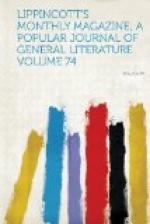Extremes meet, and modern culture, like ancient anarchy, drives its people into cities. Such is the tendency on both sides of the ocean. Improvement must result from associated effort, and of that cities are the last expression. All the European towns are outgrowing the rural districts. With us the change states itself in an advance, since 1790, of the city population from 3.4 to 20.9 per cent. of the aggregate. Broadcloth has gained on homespun in the proportion of six to one, Giles having thus six mouths to fill where he formerly had but one. We shall show farther on how gallantly he meets this draft. New York, with its suburbs, contains more Germans than any German city save Vienna and Berlin, more Irish than Dublin, and more English-speaking inhabitants than Liverpool, Birmingham, Manchester, Bristol and Leeds together. All the colonial towns in a lump would scarce add a twentieth to her numbers, and her militia embraces nearly twice as many men as served, first and last, in the Continental army.
[Illustration: The cotton gin.]
But the column that sums the souls does not state the complete life of the cities. Man has in our day a host of allies that work with him and at his command—slaves of iron, steel and brass wholly unknown to our great—grand-fathers—fed also by the farmer, through the miner as an intermediate. Steam-engines, to the number of 40,191, and of 1,215,711 horse-power—all of the stationary variety, and exclusive of nearly half as many that traverse the country and may be classed among the rural population—have succeeded the websters and spinners who were wont to clothe all the world and his wife, and who survive only in the surnames of some of our statesmen and financiers. Not that they confine their labors to textile fabrics. Their iron fingers are in every pie, including that of the printer, who is answered, when he calls the roll of his serfs of steam, by 691 whistles. And he is one of the smallest of the slaveholders—a mere ten-bale man. India-rubber, a product known a century ago only by some little black lumps used by draughtsmen to erase pencil-marks, owns enough of them to equal 4412 horses or 22,000 No. 1 field hands. Boots and shoes not




